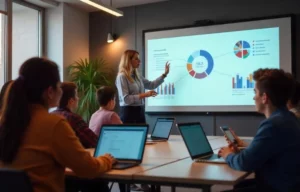

Prefer to listen instead? Here’s the podcast version of this article.
Artificial intelligence (AI) has been used in many industries over the past few years with virtually endless applications. Although much of the conversation centers around business applications and enhancing revenue opportunities, AI has the power to serve greater purposes for the benefit of society and our world. For example, AI can play a leading role in ensuring that everyone is given fair and equal opportunities. By leveraging AI’s powerful capabilities as a bridge between data sets, stakeholders — from investors to policymakers — can make fully-informed decisions about developing plans of action that address inequality on larger scales. Explore the role AI can play in reducing social and economic disparities in today’s world.
6 Ways AI Can Help Reduce Inequalities
1. Provide targeted assistance to those who are most in need
Artificial Intelligence (AI) is revolutionizing how assistance is provided to those most in need. By leveraging predictive analytics algorithms and machine learning techniques, organizations can identify patterns within populations that may not have been obvious before. This allows them to make more informed decisions about where resources should be allocated or what types of services should be provided based on accurate predictions rather than guesswork or intuition alone. Additionally, utilizing AI for targeted assistance allows for improved resource allocation for maximizing impact. For example, an organization that provides food aid could use an AI model to predict which areas will be hit hardest by a natural disaster before it happens. This would allow them to get food aid ready ahead of time so that it can be distributed as soon as possible when needed. Additionally, using predictive models based on past data, organizations can plan for future needs more accurately and effectively.
2. AI can create jobs and opportunities for those who are unemployed or underemployed.
The job market can be a challenging space for many people, but AI can help level the playing field by providing job seekers with increased access to employment opportunities and resources. The job market is changing rapidly due to automation and outsourcing—and it’s no secret that certain groups are being left behind while others reap the benefits. AI can be used to create more equitable hiring processes by incorporating data-driven insights into recruitment decisions. Using AI-powered algorithms, companies can ensure that candidates from all demographic groups have an equal chance of landing a job.
3. AI can help to improve access to education and training.
Education inequality is another primary concern for many countries around the world. Students from disadvantaged backgrounds often have fewer resources available, making it difficult for them to keep up with their peers at school or even access quality education. However, AI can be used to close this gap by providing personalized learning experiences tailored specifically to each student’s needs and interests. This could include using machine learning algorithms to develop adaptive curricula that cater to different learning styles or using natural language processing tools to provide real-time feedback on students’ work. AI could also be used in class management systems like attendance tracking or grading software, which would make it easier for teachers and administrators alike to track students’ progress and ensure they are getting the most out of their educational experience.
4. AI can help to provide better healthcare services.
Health inequity is a significant issue in many parts of the world. AI has the potential to bridge this gap by making healthcare more accessible and affordable for everyone. For example, AI algorithms can help healthcare providers diagnose diseases faster and more accurately than ever before, reducing wait times, reducing costs, and increasing access to care for all patients regardless of race or socio-economic status. Additionally, AI-powered technologies like virtual health assistants can provide personalized health advice, helping people take better care of themselves without having to go through a lengthy diagnosis process or visit a doctor’s office. Finally, AI can also reduce social inequalities by creating equal access to healthcare services through telehealth platforms such as online consultations with medical professionals or disease monitoring apps that use machine learning algorithms for diagnosis and treatment planning. For people from all walks of life, AI technology can provide better access to essential services without having any financial barriers standing in their way.
5. AI can help to promote social and economic inclusion.
AI can reduce economic inequalities by helping small businesses compete with larger ones. For example, large companies often have access to sophisticated analytics tools that smaller companies cannot afford to use on their own. With AI, however, even the smallest business can take advantage of powerful insights into customer behavior to make better decisions about allocating resources and saving money. This helps level the playing field between big and small businesses. Finally, AI can help reduce traditional barriers to entry for new businesses. By making information more accessible via automated processes, new entrepreneurs can quickly get their start-ups off the ground without worrying about competing with well-established companies that have been around for longer or have more resources at their disposal. This increases competition in markets which drives innovation while giving customers more options when shopping around.
6. AI can help to improve infrastructure.
The potential for AI lies in its ability to simplify complex processes. AI can be applied to smart energy grids and renewable energy sources. By utilizing predictive analytics, AI can anticipate demand and adjust power distribution accordingly. This would help lower energy bills and lead to a more reliable electricity supply in areas that are unreliable or unavailable due to limited infrastructure or resources. Furthermore, these changes could encourage economic growth by creating new job opportunities through technology-based businesses that are enabled by improved infrastructure.
Additionally, AI can reduce operating costs and increase efficiency through automation and data-driven decision-making. For example, in transportation networks, AI can analyze traffic patterns and predict congestion points to optimize routing decisions and provide better service for travelers. This could result in reduced traffic delays, fewer accidents, and improved safety.
Final Thoughts
Artificial intelligence is playing an important role in reducing inequalities around the world. Organizations can better allocate resources, anticipate future needs, and diagnose illnesses more accurately than ever by automating certain tasks and utilizing predictive analytics and machine learning algorithms. The result is improved outcomes for those affected by social and economic disparities. As technology continues to evolve, so will our ability to use it to reduce inequality gaps even further, making the world fairer and more sustainable for everyone.
WEBINAR